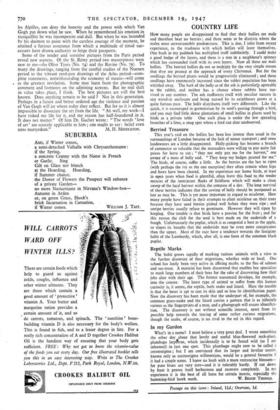ART ON Saturday afternoon the queue stretched down the steps
of the Tate, along the Embankment and round into Bulinga Street—a sight I never thought to see. Thus has the legend- grown. The man's life has been publicised, dramatised, vulgarised. The craze for reproductions equals the demand for the Tchaikevsky piano concerto. Painters of little consequence sign their pictures with their christian names. That we have been spared the ultimate indelicacy of seeing Gary Cooper cut off his ear and present it to a bowdlerised Veronica Lake is due, doubtless, to technical Wh- siderations rather than a lack of enterprise. To the sophisticated this tremendous popular appeal is suspect. Vincent's own agonised love for humanity would, perhaps, have found some solace in it " In a picture I want to say something comforting as music is comforting."
This is the most comprehensive exhibition of Van Gogh's work ever to visit Britain. The Arts Council have collected about too paintings and nearly as many drawings—loaned in the main by the Kroller-Miiller Museum and Ir. V. W. Van Gogh, the painter's nephew—which will be sent subsequently to Birmingham and Glasgow. These are arranged chronologically, so that one can study as never before the whole meteoric decade—the plodding, sentimental apprenticeship, the gathering momentum, the first glow in Paris, to the blazing white-heat of Provence, where, meteor-like, he was con- sumed by his own fires. One's first reaction—perhaps it is the austerity framing—is of reproductions in a works canteen. Then the intensity of colour and the massive impasto register their existence.
Poor splendid Vincent ; lacerated, tender, suffering Vincent—does anything remain to be said ? He could no more draw than Blake could draw. Yet, like Blake, so strongly did he feel the tragedy of mankind, so genuine was the magnitude of his love, so overwhelming the vast, vehement necessity to disgorge all that was in him, that he found a means of communicating, within a mere ten years, a time- less and fashionless truth denied to more accomplished painters. I do not believe anyone familiar with the Camargue, the Crau and
les Alpilles, can deny the honesty and the power with which Van Gogh put down what he saw. When he remembered his emotion in tranquillity he was incompetent and dull. But when he was hounded by his daemon to paint with the careless courage of the moment, he attained a furious assurance from which a multitude of timid suc- cessors have drawn authority to forge their passports. Some of the tender and sensitive pictures from the Paris period reveal new aspects. Of the St. Remy period two masterpieces were new to me—the Olive Trees (No. 74) and the Ravine (No. 79). To many the drawings, ranging from the careful studies of the iguenen period to the vibrant reed-pen drawings of the Arles period—com- plete statements, notwithstanding the economy of means—will come as the greatest revelation. Some may learn from the photographic comment and footnotes on the adjoining screens. But no real shift in value takes place, I think. The best pictures are still the best known. Does anything remain to be said ? Not in this generation. Perhaps in a future and better ordered age the violence and passion of Van Gogh will jar where today they reflect. But for us it is almost impossible to dissociate the art from the life. " Ah well, my work—I have risked my life for it, and my reason has half-foundered in it. It does not matter." Of him Dr. Gachet wrote: " The words ' love of art' are scarcely applicable to him ; one ought to say : belief even



































 Previous page
Previous page